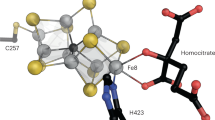Abstract
In vivo switch-off of nitrogenase activity by NH +4 is a reversible process in Rhodobacter sphaeroides and Methylosinus trichosporium OB3b. The same pattern of switch-off in Rhodospirillum rubrum is explained by ADP-ribosylation of one of the Fe protein subunits, however, no evidence of covalent modification could be found in the subunits from either R. sphaeroides or M. trichosporium. Fe protein subunits from these organisms showed no variant behaviour on SDS-PAGE, nor were they 32P-labeled following switch-off. These observations suggest either that the attachment of the modifying group to the Fe protein in these organisms is quite labile and does not survive in vitro manipulation, or that the mechanism of switch-off is different than that seen in Rhodospirillum.
Similar content being viewed by others
References
Carithers RP, Yoch DC, Arnon DI (1979) Two forms of nitrogenase from the photosynthetic bacterium Rhodospirillum rubrum. J Bacteriol 137:779–789
Dalton H, Whittenbury R (1976) The acetylene reduction technique as an assay for the nitrogenase activity in the methane oxidizing bacterium Methylococcus capsulatus strain Bath. Arch Microbiol 109:147–151
Gotto JW, Yoch DC (1982) Regulation of Rhodospirillum rubrum nitrogenase activity. Properties and interconversion of active and inactive Fe protein. J Biol Chem 257:2868–2873
Gotto JW, Yoch DC (1985) Regulation of nitrogenase activity by covalent modification in Chromatium vinosum. Arch Microbiol 141:40–43
Haaker H, Laane C, Hellinwerf K, Houwer B, Konings WN, Veeger C (1982) Short-term regulation of the nitrogenase activity in Rhodopseudomonas sphaeroides. Eur J Biochem 127:639–645
Hartmann A, Fu H, Burris RH (1986) Regulation of nitrogenase activity by ammonium chloride in Azospirillum spp. J Bacteriol 165:864–870
Jones BL, Monty KJ (1979) Glutamine as a feedback inhibitor of the Rhodopseudomonas sphaeroides nitrogenase system. J Bacteriol 139:1007–1013
Jouanneau Y, Meyer CM, Vignais PM (1983) Regulation of nitrogenase activity through iron protein interconversion into an active and an inactive form in Rhodopseudomonas capsulata. Biochim Biophys Acta 749:318–328
Kanemoto RH, Ludden PW (1984) Effect of ammonia, darkness and phenazine methosulfate on whole-cell nitrogenase activity and Fe protein modification in Rhodospirillum rubrum. J Bacteriol 158:713–732
Kush A, Elmerich C, Aubert J-P (1985) Nitrogenase of Sesbania Rhizobium strain ORS571: Purification, properties and ‘switch-off’ by ammonia. J Gen Microbiol 131:1765–1777
Laemmli UK (1970) Cleavage of structural proteins during the assembly of the head of bacteriophage T4. Nature (Lond) 227:680–685
Li J, Hu C-Z, Yoch DC (1987) Changes in amino acid and nucleotide pools of Rhodospirillum rubrum during switch-off of nitrogenase activity initiated by NH +4 or darkness. J Bacteriol 169:231–237
Ludden PW, Burris RH (1976) Activating factor for the iron protein of nitrogenase from Rhodospirillum rubrum. Science 194:424–426
Ludden PW, Burris RH (1978) Purification and properties of nitrogenase from Rhodospirillum rubrum and evidence for phosphate. ribose, and an adenine-like unit covalently bound to the iron protein. Biochem J 175:251–259
Ludden PW, Okon Y, Burris RH (1978) The nitrogenase system of Spirillum lipoferum. Biochem J. 173:1001–1003
Murrell C, Dalton H (1983) Nitrogen fixation in obligate methanotrophs. J Gen Microbiol 129:3481–3486
Nordlund, S., Eriksson U (1979) Nitrogenase from Rhodospirillum rubrum. Relation between ‘switch-off’ effect and membrane component. Hydrogen production and acetylene reduction with different nitrogenase component ratio. Biochim Biophys Acta 547:429–437
Ormerod JG, Ormerod KS, Gest H (1961) Light-dependent utilization of organic compounds and photoproduction of molecular hydrogen by photosynthetic bacteria; relationship with nitrogen metabolism. Arch Biochem 94:449–463
Pope MP, Murrell SA, Ludden PW (1985) Covalent modification of the iron protein of nitrogenase from Rhodospirillum rubrum by adenosine diphosphoribosylation of a specific arginine residue. Proc Natl Acad Sci USA 82:3171–3177
Preston GG, Ludden PW (1982) Changes in subunit composition of the iron protein of nitrogenase from Rhodospirillum rubrum during activation and inactivation of iron protein. Biochem J 205:489–494
Reich S, Almon H, Böger P (1986) Short-term effect of ammonia on nitrogenase activity of Anabaena variabilis (ATCC29413). FEMS Microbiol Lett 34:53–56
Smith RL, van Baalen C, Tabita FR (1987) Alteration of the Fe protein in the cyanobacterium Anabaena sp. strain CA. J Bacteriol 169:2537–2542
Yoch DC, Cantu M (1980) Changes in the regulatory forms of Rhodospirillum rubrum nitrogenase as influenced by nutritional and environmental factors. Bacteriol 142:899–907
Author information
Authors and Affiliations
Rights and permissions
About this article
Cite this article
Yoch, D.C., Li, J., Hu, CZ. et al. Ammonia switch-off of nitrogenase from Rhodobacter sphaeroides and Methylosinus trichosporium: no evidence for Fe protein modification. Arch. Microbiol. 150, 1–5 (1988). https://doi.org/10.1007/BF00409708
Received:
Accepted:
Issue Date:
DOI: https://doi.org/10.1007/BF00409708




